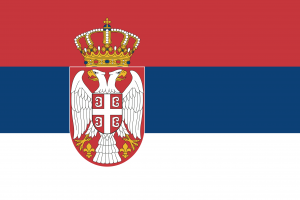Language/Serbian/Vocabulary/Greetings-and-Introductions
 Հայերէն
Հայերէն Български език
Български език 官话
官话 官話
官話 Hrvatski jezik
Hrvatski jezik Český jazyk
Český jazyk Nederlands
Nederlands English
English Suomen kieli
Suomen kieli Français
Français Deutsch
Deutsch עברית
עברית हिन्दी
हिन्दी Magyar
Magyar Bahasa Indonesia
Bahasa Indonesia فارسی
فارسی Italiano
Italiano 日本語
日本語 Қазақ тілі
Қазақ тілі 한국어
한국어 Lietuvių kalba
Lietuvių kalba Νέα Ελληνικά
Νέα Ελληνικά Şimali Azərbaycanlılar
Şimali Azərbaycanlılar Język polski
Język polski Português
Português Limba Română
Limba Română Русский язык
Русский язык Español
Español العربية القياسية
العربية القياسية Svenska
Svenska Wikang Tagalog
Wikang Tagalog தமிழ்
தமிழ் ภาษาไทย
ภาษาไทย Türkçe
Türkçe Українська мова
Українська мова Urdu
Urdu Tiếng Việt
Tiếng Việt
| ◀️ Verbs: Past Tense — Previous Lesson | Next Lesson — Numbers and Counting ▶️ |
As a Serbian language teacher with 20 years of experience, I know that starting to learn a new language can be both exciting and challenging. In this lesson, we will cover some common Serbian phrases for greeting and meeting people. By the end, you will be able to confidently introduce yourself and communicate basic pleasantries in Serbian.
After mastering this lesson, these related pages might interest you: Adverbs in Serbian & Family members.
Greetings[edit | edit source]
When you meet someone for the first time or see them again after a while, the most common greeting in Serbian is "zdravo" (Здраво). It is pronounced "zdrah-vo" and can be used in formal and informal situations. Other informal greetings include:
- Ćao (Чао) - pronounced "chao", meaning "hi" or "bye" (informal)
- Dobar dan (Добар дан) - pronounced "doh-bar dan", meaning "good day" (formal)
- Dobro veče (Добро вече) - pronounced "doh-bro ve-che", meaning "good evening" (formal)
Introductions[edit | edit source]
When introducing yourself or someone else, it's important to know how to say "my name is" and "nice to meet you" in Serbian. Here are some useful phrases:
- Ja se zovem... (Ја се зовем...) - pronounced "yah se zoh-vem", meaning "my name is..."
- Drago mi je da sam vas/te upoznao/la (Драго ми је да сам вас/те упознао/ла) - pronounced "drah-go mee yah dah sahm vahs/teh oo-po-znah-o/la", meaning "nice to meet you" (formal/informal)
Here are some examples of how to introduce yourself in Serbian:
| Serbian | Pronunciation | English |
|---|---|---|
| Zdravo, ja se zovem Ana. | Zdrah-vo, yah se zoh-vem Ah-na. | Hi, my name is Ana. |
| Ćao, ja sam Marko. | Chao, yah sahm Mar-ko. | Hi, I'm Marko. |
And here are some examples of how to introduce someone else in Serbian:
| Serbian | Pronunciation | English |
|---|---|---|
| Dobar dan, ovo je moj kolega Ivan. | Doh-bar dan, oh-vo yeh moy ko-le-gah Ee-van. | Good day, this is my colleague Ivan. |
| Dragi prijatelji, dozvolite mi da vam predstavim moju ženu, Jelenu. | Drah-gee pree-ya-te-lyee, dohz-vo-lee-te me dah vahm prehdsta-veem moyoo zheh-noo, Yeh-leh-noo. | Dear friends, allow me to introduce you to my wife, Jelena. |
Small Talk[edit | edit source]
Once you have introduced yourself, it's always helpful to know how to continue the conversation. Here are some basic Serbian phrases for small talk:
- Kako ste? (Како сте?) - pronounced "kah-ko steh", meaning "how are you?" (formal)
- Kako si? (Како си?) - pronounced "kah-ko see", meaning "how are you?" (informal)
- Hvala, dobro sam. A vi/ ti? (Хвала, добро сам. А ви/ти?) - pronounced "hva-la, doh-bro sahm. Ah vee/tee?", meaning "Thank you, I'm fine. And you?" (formal/informal)
Here are some examples of how to use these phrases in a conversation:
| Serbian | Pronunciation | English |
|---|---|---|
| Zdravo, kako ste? | Zdrah-vo, kah-ko steh? | Hi, how are you? (formal) |
| Ćao, kako si? | Chao, kah-ko see? | Hi, how are you? (informal) |
| Hvala, dobro sam. A ti? | Hva-la, doh-bro sahm. Ah tee? | Thank you, I'm fine. And you? (informal) |
Conclusion[edit | edit source]
Learning new greetings and introductions is a crucial part of starting a new language learning journey. In this lesson, we have covered some common Serbian phrases for greeting and meeting people. Remember to practice saying these phrases aloud, and don't be afraid to make mistakes. With time and practice, you will be able to communicate more confidently in Serbian.
Sources[edit | edit source]
- How to say hello in Serbian: 10 useful ways ways to say hi
- SOLT Serbian Module 1 Lesson 2 Greetings and Introductions
- Learn Serbian - Free Serbian Lessons | L-Lingo
Congratulations on finishing this lesson! Explore these related pages to keep learning: Food and Drink & Movies and Theater.
Videos[edit | edit source]
Greetings in Serbian - A Serbian Lesson by Serbonika - YouTube[edit | edit source]
Other Lessons[edit | edit source]
- Family members
- Weather
- City
- Travel
- Shapes
- Sports
- Education
- Verbs in Serbian
- Family
- Adjectives in Serbian
| ◀️ Verbs: Past Tense — Previous Lesson | Next Lesson — Numbers and Counting ▶️ |

